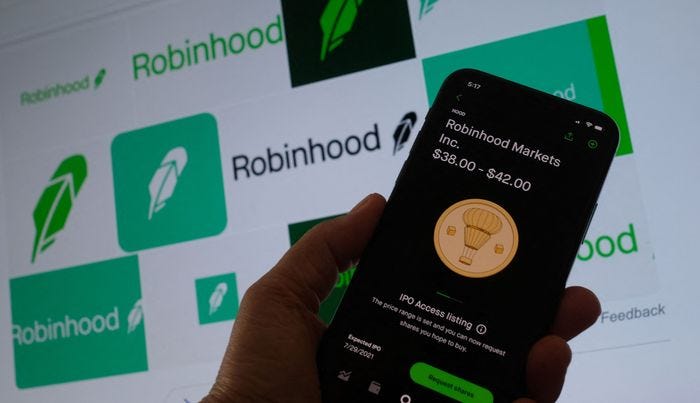Do Early Robinhood Investors See The Writing On The Wall?
Hours after the company discloses new risks, insiders seek to speed up share sales.
At the beginning of the week last week, I wrote about a “sneaky” pair trade idea that involved carefully shorting Robinhood and going long another name I thought had 50% upside (subscribers have access here).
My thesis on shorting Robinhood was the company was already trading in bubble territory and facing a significant amount of risk around crypto customer concentration and potential banning of the payment for order flow model.
Now, it looks as though my thesis for the name could be beginning to play out.
Late in the week this past week, Robinhood disclosed that existing shareholders wanted to speed up a share sale just hours after the company made new risk disclosures surrounding these issues.
Robinhood’s stock was lower by 1.75% in after hours trading on Friday, after news of the share sale broke. The urge to sell came just hours after Bloomberg wrote:
Robinhood Markets Inc. said that regulatory intervention in cryptocurrency trading, and in a payment arrangement between brokerages and trading firms, could pose risks to its business.
The Menlo Park, California-based brokerage cited the risks Friday in an amended filing, seeking to speed up approval for a previously announced shareholder stock sale.
Recall, earlier in the week, I made my case that Robinhood’s valuation is simply a bubble, in my opinion.
The company moved as high as $52 per share at one point, all on an orchestrated gamma squeeze by the folks over at Wallstreetbets, I wrote. This took an already overvalued name at the time of its IPO and stretched its valuation into stratospheric territory.
I continued making my case:
Robinhood had trouble finding a bid at its $37/share valuation when it went public and, since then, has done nothing but reported Q2 earnings that included a warning about a slowdown in trading activity, either setting the stage for a rougher Q3 or sandbagging.
The company’s revenue stream is becoming increasingly dependent on its crypto trading business at a time when U.S. regulators have admitted they won’t ban bitcoin, but still have a long way to go in setting rules for the new asset class.
Finally, the company’s payment for order flow model could be at risk…
It now looks as though company insiders, seeking to sell their shares in expedited fashion, may be seeing the same writing on the wall.
Under the amended plan, Robinhood stockholders could sell as soon as Wednesday of this upcoming week.
On October 4, 2021, the day I released my article, HOOD opened at $41.80 and the long end of the trade, VIRT, opened at $24.83.
HOOD ended the week at $41.05 in the after hours session, down -1.79% since Monday and VIRT ended the week at $25.62, up 3.18% since the idea.
DISCLAIMER:
I’m long VIRT and VIRT calls and short HOOD via puts. None of this is a solicitation to buy or sell securities. It is only a look into my personal opinions and portfolio. These positions can change immediately as soon as I publish this, with or without notice. You are on your own. Do not make decisions based on my blog. I exist on the fringe and there is far more risk associated with my ideas than those of “normal” Wall Street people.
MORE DISCLAIMER:
These are not the opinions of any of my employers, partners, or associates. I get shit wrong a lot. If I am here listing things I got right or thinks I think will happen in the future, note that there are likely twice as many things I got wrong over the same period of time. I’m not a financial advisor, I hold no licenses or registrations and am not qualified to give advice on anything, let alone finance or medicine. Talk to your doctor, talk to your financial advisor or your therapist for professional advice. Most of the time I am literally blogging in my underwear or pajamas. I almost never wear ties or suits. Leave me a alone and do your research elsewhere. If you can find somewhere to rate this Substack one star, please do so as to save future readers from the misery of my often wholly incorrect prognostications.




